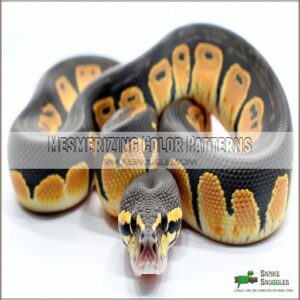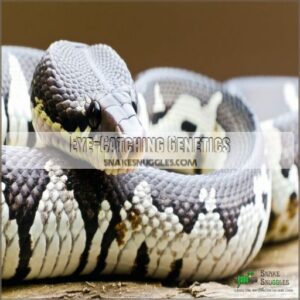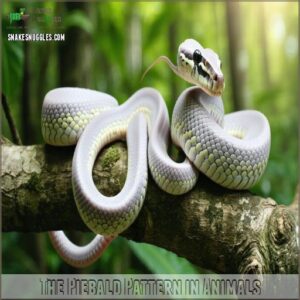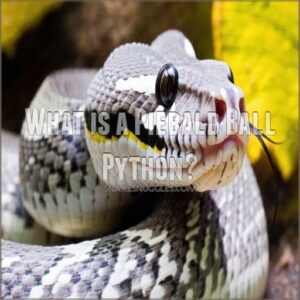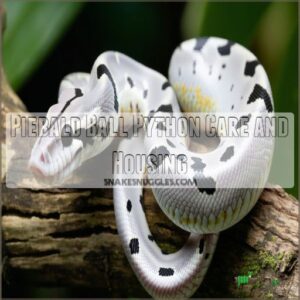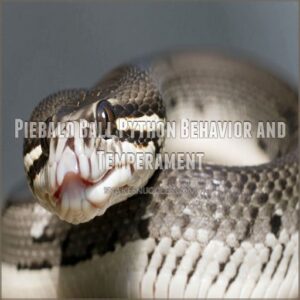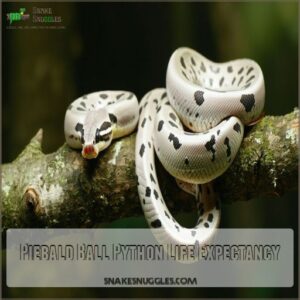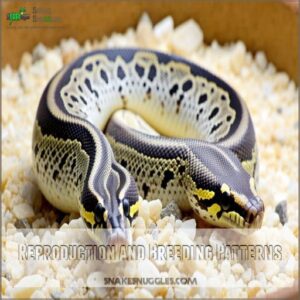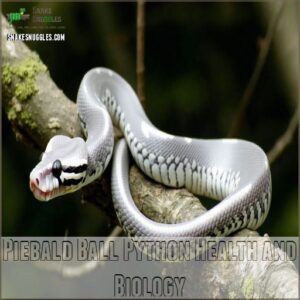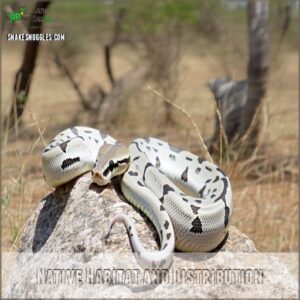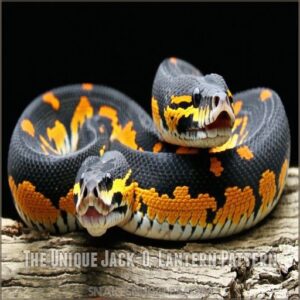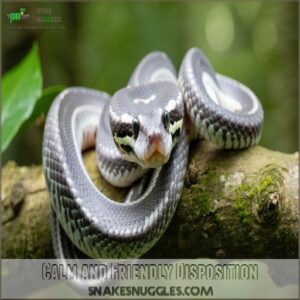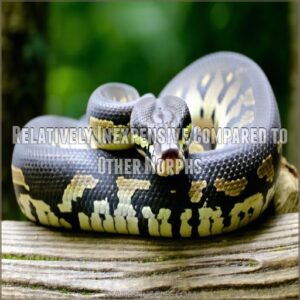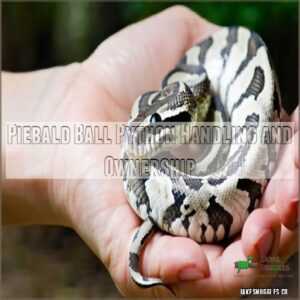This site is supported by our readers. We may earn a commission, at no cost to you, if you purchase through links.
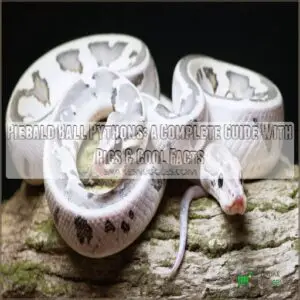
These gentle giants typically reach 4-5 feet long and live 20-30 years with proper care.
They’re not just beautiful but also make fantastic pets thanks to their calm, docile nature.
In the wild, they’re native to West Africa, but they’ve become prized pets worldwide.
While they share basic care needs with regular ball pythons, Piebald ball pythons captivate with their striking contrast of unpigmented white patches and normal coloration, making them a popular example of color morphs in ball pythons. Their unique genetics make them special.
The secret to their stunning appearance lies in a fascinating genetic story that’s revolutionized snake breeding.
Table Of Contents
- Key Takeaways
- Piebald Ball Python Description
- What is a Piebald Ball Python?
- Piebald Ball Python Care and Housing
- Piebald Ball Python Behavior and Temperament
- Piebald Ball Python Life Expectancy
- Reproduction and Breeding Patterns
- Piebald Ball Python Health and Biology
- Native Habitat and Distribution
- Piebald Ball Python Interesting Facts
- Piebald Ball Python Handling and Ownership
- Frequently Asked Questions (FAQs)
- What is a piebald Python?
- Do ball pythons have piebaldism?
- What makes a piebald ball python a piebald?
- How big is a piebald ball python?
- What is a piebald ball python morph?
- When was the piebald ball python morph discovered?
- What are the facts about pied ball pythons?
- What is the lifespan of a piebald ball python?
- How big do piebald ball pythons get?
- Are piebald ball pythons rare?
- What do piebald ball python hatchlings look like?
- How often should I feed my piebald python?
- Can piebald ball pythons live with other snakes?
- Are piebald patterns inherited from both parent snakes?
- Do piebald ball pythons shed differently than normal morphs?
- Conclusion
Key Takeaways
- You’ll find piebald ball pythons showcase a striking white base color with random patches of orange and black patterns, making each snake uniquely patterned like a living piece of art.
- You’ll need to maintain their enclosure at 78-80°F ambient temperature with 60-80% humidity during the day, providing a 36x18x12 inch tank for optimal housing.
- You can expect your piebald ball python to reach 4-5 feet in length, live 20-30 years with proper care, and display a gentle, docile temperament that makes them excellent pets.
- You’ll discover breeding requires careful attention to incubation temperatures (88-92°F), with females reaching sexual maturity around two years and producing clutches of up to eleven eggs.
Piebald Ball Python Description
When you glimpse a piebald ball python, you’ll immediately notice its stunning white skin splashed with random patches of orange and black, making it look like a living Halloween decoration.
This snake’s eye-catching, piebald pattern isn’t just for show—it’s all in the genes, unique among its scaly relatives.
Mesmerizing Color Patterns
With Piebald Ball Pythons, you’re greeted with a color show like no other.
Imagine bright splashes of orange and black scattered randomly across a pure white canvas—it’s nature’s abstract art!
Each snake is unique, thanks to its distinct patterns, offering a visual treat that doesn’t fade.
These mesmerizing color variations truly highlight the playful quirks of morph breeding.
Eye-Catching Genetics
Imagine discovering a genetic mystery wrapped in vibrant hues.
Piebald Ball Pythons owe their stunning look to intriguing genetic mutations.
Through the complex process of genetic variations influencing snake appearance, including polygenic inheritance and dominant genes, enthusiasts craft these rare morphs with dramatic color variations.
Breeding programs carefully pair snakes to guarantee the eye-catching designs flourish, transforming nature’s palette into a breathtaking display.
It’s nature’s artistry, curated by human hands, truly amazing!
The Piebald Pattern in Animals
Piebald coloring isn’t unique to ball pythons; it’s a genetic quirk showing up in many animals.
Think of it as nature’s confetti – random splashes of white against a base color.
Horses, dogs, and even cows can sport this striking pattern.
This "Piebald genetics" variation highlights animal diversity and the fascinating world of pattern variations.
Understanding this helps with breed history and even conservation concerns.
It’s a reminder of how wonderfully weird nature can be!
What is a Piebald Ball Python?
You’re about to discover the fascinating Piebald Ball Python, a unique snake featuring striking white patches and colorful patterns that look like something out of a modern art gallery.
Hailing from West Africa, these amazing creatures sport a rare and enchanting piebald pattern, making them standout members of the ball python family.
Appearance and Characteristics
You’ve spotted a colorful pet like no other—piebald ball pythons dazzle with splashes of orange and black on a white backdrop.
It’s a pattern straight out of a painter’s dream, yet it’s all in their genetics.
This morph isn’t just eye candy; it’s a fascinating twist of nature, wrapping striking snake anatomy in hues fans adore.
Habitat and Origins in West Africa
West Africa’s vibrant landscapes shape the lives of Piebald Ball Pythons, where the heat can be intense, demanding clever survival tactics. This biodiverse region presents unique challenges and opportunities for these snakes. The tropical savanna grasslands and open forests of Sub-Saharan Africa, known as the ball python natural habitat, play a key role in shaping their behavior and adaptations.
- West African climate: Relentless heat influences behavior.
- Snake adaptations: Thrive among various threats.
- Biodiversity: A rich ecosystem.
- Conservation efforts: Essential to their future.
Rarity of The Piebald Pattern in Snakes
Snakes with piebald genetics are like nature’s lottery ticket—you don’t see ’em often.
This color mutation, a rare morph, involves genetic inheritance that creates a striking pattern.
While lots of animals sport similar looks, piebald snakes are special.
Their unique color variations make them standout in the reptile world, offering a whimsical twist on typical snake appearances.
Piebald Ball Python Care and Housing
When you care for a Piebald Ball Python, you’ll need to set up a cozy home with just the right tank size and climate control.
These fascinating snakes have particular needs, from temperature to tasty snacks, so getting the details right is key to a happy python.
Tank Specifications and Ventilation
So, you’ve got your amazing piebald ball python.
Now, let’s talk housing!
A 36x18x12 inch tank is perfect for an adult.
Make sure it’s escape-proof—these guys are sneaky!
Good ventilation is key; you don’t want your snake getting stuffy.
Choose a substrate that’s easy to clean and safe for your pet.
Think of it as building a five-star hotel for your scaly friend.
Temperature and Humidity Management
You’ve set up the tank, now let’s make it cozy. Think of it like crafting the perfect home environment.
Humidity levels should stick between 60-80% during the day and 80-100% at night, as recommended for ball python temperature requirements.
Use heat source types like ceramic heaters to create a thermal gradient.
Aim for an ambient temperature of 78-80°F.
Proper tank ventilation helps prevent stuffy air.
Diet and Feeding Habits
While managing their habitat, let’s chow down on the diet. You can find a variety of products designed for their needs at an online store like Piebald ball python diet.
Feeding piebald ball pythons involves:
- Feeding Schedule: Weekly meals keep them happy.
- Prey Size: Opt for rodents equal to your python’s girth.
- Dietary Needs: Balanced meals without overfeeding.
- Nutritional Supplements: Optional, but sometimes helpful.
It’s feeding, not a feast! Keep them comfy and healthy.
Piebald Ball Python Behavior and Temperament
Get ready to discover the charming personality of piebald ball pythons, known for their mostly calm nature with a touch of occasional sassiness.
These snakes love human interaction and can become your scaled buddy for life, promising both gentle companionship and a remarkable growth journey.
Defensive Behavior and Occasional Aggression
Think of your Piebald Ball Python like a shy friend.
Stress triggers defensive mechanisms, like curling up or hissing.
They’re generally calm, but gentle handling is key to avoid occasional aggression.
Check out these safety tips:
| Situation | Reaction |
|---|---|
| Loud Noises | Hiding or Hissing |
| Quick Movement | Striking |
| Handling | Stay Calm |
Understanding their behavior leads to bite prevention and safe handling!
Handling and Interaction With Owners
Handling your Piebald Ball Python feels like whispering secrets of the wild. Engage with:
- Safe handling techniques: be gentle and patient.
- Owner-snake bonding: regular contact teaches trust.
- Social interaction needs: snakes may enjoy exploring your hand.
- Stress signs in snakes: look for twitching or hissing.
Remember, handling frequency matters—your python loves routine, just like a good friend does.
Growth Rate and Life-Long Friendships
Imagine your piebald ball python growing a foot each year until maturity—it’s like having a fast-growing pet you can bond with for life.
Their long lifespan means you’ll share years of companionship.
Regular handling boosts this friendship, and you’ll find their calm nature comforting.
Patience and care are key, so enjoy the journey with these fascinating creatures.
Piebald Ball Python Life Expectancy
You’ll be happy to know that piebald ball pythons can live for 20 to 30 years in the care of a loving owner, making them a potentially long-term commitment!
However, their lifespan in the wild is often shorter due to things like predators and harsh weather, so responsible captive care is key to ensuring a long and healthy life for your scaly friend.
Captive Life Expectancy
Your piebald ball python can live a long and happy life, often reaching 20 to 30 years in captivity if cared for well.
Diet and enrichment play huge roles in this.
Keeping stress low and monitoring health regularly will help guarantee a longer lifespan.
So, think of it like maintaining a classic car—attention and care mean everything in extending its journey.
Sheltering Habits in The Wild
While Piebald Ball Pythons in captivity easily reach ripe old ages, their wild counterparts have more challenges, with a natural lifespan of around 10-15 years due to factors such as predation and habitat loss, which are essential to their survival in their natural West and Central African habitats like savannahs and sparsely wooded areas.
These snakes often seek out burrows left by other animals to avoid predators and survive extreme climate changes.
Their habitat choice, dictated by seasonal variations, helps them stay cool or escape threats, making clever use of natural shelters important to their survival.
Factors Affecting Life Expectancy
Natural predators, disease, stress, genetics, and environment affect a Piebald Ball Python’s life expectancy.
Predation in the wild shortens lives, while captive pythons live longer due to fewer threats.
Stress from poor habitat conditions and diseases can also impact health.
Good care and attention to genetics can help guarantee these engaging reptiles live their full 20 to 30 years.
Reproduction and Breeding Patterns
Breeding piebald ball pythons can be quite the adventure, as they reach maturity around two years and produce clutches of up to eleven eggs.
Keep the eggs at just the right temperature, about 88 to 92 degrees Fahrenheit, and watch these fascinating snakes hatch, ensuring a new generation of these uniquely patterned reptiles.
Maturity and Reproductive Patterns
Get ready to explore the world of Piebald Ball Python breeding!
These fascinating snakes reach sexual maturity around two years old.
Imagine mating season—a time of intricate rituals and vibrant energy.
Females lay clutches varying in size, often influenced by their environment and health.
The parenting role isn’t prominent, but the complex dance of life continues impressively.
Incubation Temperatures and Egg-Laying
After reaching maturity, piebald ball pythons are ready for egg-laying.
Keeping an eye on incubation temperatures is key—the clutch size can vary from just a few to over ten eggs.
You’ll want to keep temperatures steady at around 88 to 90°F.
With the right temperature control, you’re on the path to successful breeding and healthy hatchlings.
Breeding in Captivity
Breeding piebald ball pythons in captivity requires careful planning.
Successful captive breeding hinges on understanding their needs, including proper temperature and humidity control during incubation, which can be achieved with the right ball python incubator setup.
Ethical considerations, like maintaining genetic diversity, are super important.
You’ll also need to learn about specialized breeding techniques, such as those involving a reliable incubation equipment supplier.
Following established incubation protocols increases your chances of hatching healthy babies.
It’s a rewarding, albeit challenging, journey!
Piebald Ball Python Health and Biology
Regarding piebald ball python health and biology, you’ll find these snakes are generally hardy but can face common reptile issues like respiratory infections.
Understanding their biology helps guarantee they thrive in your care, and knowing their needs can make you the best snake parent on the block!
Potential Health Issues
Just like with breeding, you’ll need to keep a sharp eye on potential health issues.
Parasite prevention is a must, along with solid husbandry practices to fend off respiratory problems.
Genetic disorders and nutritional deficiencies can pop up too.
Think of your python as a picky eater with peculiar habits, needing your watchful care and attention to thrive.
Biology and Reproduction
A piebald ball python’s biology is fascinating, especially as they reach sexual maturity.
During the breeding season, these snakes showcase unique habits.
Females lay egg clutches ranging from one to eleven eggs.
The incubation time is essential for healthy offspring.
Ensuring proper care and conditions helps these baby pythons thrive, continuing the cycle of this intriguing species.
Scientific Classification and Conservation Status
Curious about the Piebald Ball Python‘s place in the animal world? They’re part of the Python regius clan! Though these beauties aren’t on the IUCN’s endangered list, conservation efforts are key to keeping their genetic diversity thriving. Engaging in captive breeding programs helps maintain healthy population trends. Just imagine each python as a link in a vibrant ecological chain.
- IUCN Status: Not endangered
- Genetic Diversity: Important for healthy populations
- Captive Breeding Programs: Support species survival
- Conservation Efforts: Maintain environmental balance
Native Habitat and Distribution
You’ll find piebald ball pythons hanging out in the varied climates of West Africa, where they thrive in places like Senegal, Mali, and Guinea.
These areas offer a mix of heat and limited rainfall, shaping the snakes’ unique survival tactics.
They share their home turf with a fascinating array of other species.
West Africa’s Climate and Ecosystems
West Africa’s climate is like a rollercoaster, with rainfall patterns that shape its diverse ecosystems.
Home to the piebald ball python, this region sees snazzy adaptations in its snakes to cope with shifts.
From lush greens to arid stretches, climate change impacts these habitats, sparking conservation efforts to make sure these incredible ecosystems stay vibrant and thriving.
Natural Behavior and Survival Strategies
Africa’s climate directly impacts how these snakes survive.
Limited rainfall means they need clever strategies.
Think of it like a puzzle; they need to find food and shelter.
Camouflage helps them hide from predators.
Burrowing provides protection from the heat and keeps them safe.
Their food sources are mainly small mammals.
Finding these resources is key to their survival.
They aren’t known for hibernation, though.
Similar Species and Habitats
Diving into ball python morphs, you’ll find similarities with other West African snakes, shaped by their habitat diversity.
These ecosystems influence behaviors and survival strategies.
Here are four interesting points about similar species:
- Adaptations to dry climates.
- Unique color morphs.
- Conservation efforts underway.
- Diverse feeding habits.
Piebald Ball Python Interesting Facts
You’ll love the quirky charm of Piebald Ball Pythons, with their unique Jack-o-Lantern pattern that turns heads and sparks fascination.
These pythons aren’t just eye-catching; they’re also calm, friendly companions that won’t break the bank compared to other morphs.
The Unique Jack-O-Lantern Pattern
Imagine spotting these fascinating Piebald Ball Pythons, their skin a living mosaic of colors.
The unique jack-o-lantern pattern, with startling orange splotches and dark contrasts, evokes Halloween tales.
Here’s a quick snapshot:
| Piebald Patterns | Emotions Evoked |
|---|---|
| Orange Splotches | Curiosity |
| Black Contrasts | Mystery |
| Random Design | Excitement |
| Nature’s Art | Wonder |
Piebald genetics never fail to impress!
Calm and Friendly Disposition
Though piebald ball pythons look fierce, they’re surprisingly gentle and calm, making them a great pet choice, as they’re known for their generally docile and calm nature characteristic of the Piebald Ball Python Temperament.
With a friendly temperament, these snakes enjoy handling and socialization, especially with a little patience.
Think of them as the shy friend who opens up once comfortable.
Building this relationship with your python can lead to rewarding interactions and companionship.
Relatively Inexpensive Compared to Other Morphs
Ready for a budget-friendly pet? Piebald Ball Pythons are a great option. Compared to other morphs, they’re a bargain. You can even find a range of affordable options at websites that specialize in cheap ball python morphs.
Here’s why:
- Cost Comparison: They offer great value for money.
- Morph Prices: Lower prices than rarer morphs.
- Affordable: Easier on the wallet.
- Value: Beautiful and budget-friendly.
Perfect for snake enthusiasts looking for something unique!
Piebald Ball Python Handling and Ownership
You’ll find that owning a piebald ball python isn’t just about having a pet – it’s about creating a lifelong bond with a creature that can live up to 30 years.
With their gentle nature and striking appearance, these snakes make fantastic companions when you provide the right care, including proper housing, consistent handling, and daily attention to their needs.
Daily Interactions and Attention Needs
Many Piebald Ball Python owners find daily interaction essential for socialization and enrichment.
You’ll want to handle your snake for 15-20 minutes each day, helping them stay comfortable with human contact.
Here’s a quick guide to effective interaction:
| Activity | Frequency | Benefits |
|---|---|---|
| Gentle Handling | Daily | Reduces stress, builds trust |
| Feeding Time | Weekly | Strengthens bond, maintains health |
| Health Check | Weekly | Makes sure wellbeing, prevents issues |
| Exploration Time | Bi-weekly | Provides mental stimulation |
Housing and Care Requirements
Your piebald ball python’s home sweet home starts with a spacious 36x18x12-inch tank, complete with proper ventilation to prevent any sneaky escape attempts.
You’ll need to maintain warm-side temperatures between 88-92°F and cool-side temps at 78-80°F.
Keep humidity levels in check and provide fresh water daily.
For substrate, opt for coconut fiber or cypress mulch to help maintain moisture.
Preparing for a Life-Long Commitment
Making space for a piebald ball python means committing to 20-30 years of care.
Before diving in, you’ll need proper housing, weekly food costs, and vet savings.
It’s also essential to learn about safe handling techniques, such as pre-handling preparations and stress management.
It’s worth researching local reptile vets and joining online communities for support.
Taking responsibility also means setting aside time for daily interaction and regular tank maintenance to keep your scaly friend healthy and happy.
Frequently Asked Questions (FAQs)
What is a piebald Python?
A piebald ball python is a stunning snake with unique white patches and colored splotches across its body.
You’ll notice its distinctive Jack-o’-lantern pattern, making it one of the most eye-catching python morphs available.
Do ball pythons have piebaldism?
Yes, ball pythons can develop piebaldism, a genetic mutation creating distinctive white patches with colored spots.
Piebaldism makes them stand out among other morphs in the reptile world.
This unique pattern, resembling a jack-o’-lantern design, makes them stand out among other morphs in the reptile world.
What makes a piebald ball python a piebald?
A piebald ball python’s distinctive trait comes from its rare genetic pattern, featuring a characteristic head typically black or dark brown with stripes, resembling a normal ball python, which is a result of genetic mutation disrupting pigment. A piebald ball python’s distinctive trait comes from its rare genetic pattern, featuring a white base color with scattered patches of normal coloring.
It’s like nature painted random splotches on a pristine white canvas.
How big is a piebald ball python?
At maturity, female piebald ball pythons grow up to 5 feet long, while males reach 5 feet. You’ll notice they’re quite stocky too, typically weighing between 4-5 pounds when fully grown.
What is a piebald ball python morph?
A piebald ball python’s overall color, pattern, blushing, and eye color are key factors to consider for identifying ball python morphs. A piebald ball python‘s a stunning morph with unique white base coloring and random patches of normal patterns.
You’ll notice it looks like nature painted a jack-o’-lantern design across its scales.
When was the piebald ball python morph discovered?
Like a rare gem discovered in nature’s vault, the piebald ball python morph is a standout due to its striking white and dark pigmentation contrast, characteristic of Ball Python Morphs. The piebald ball python morph was first documented in 1966 when villagers found a large male specimen in Ghana.
You’ll appreciate that this discovery sparked decades of fascination.
What are the facts about pied ball pythons?
Piebald ball pythons display stunning white patches with orange and black splotches.
You’ll find they’re gentle pets living 20-30 years, reaching 4 feet long, and thriving in tanks with proper temperature zones.
What is the lifespan of a piebald ball python?
You’ll be amazed – your piebald ball python can be your companion for up to 30 years in captivity!
While they typically live 20-30 years with proper care, they don’t live quite as long in nature.
How big do piebald ball pythons get?
Expect your pet to reach impressive dimensions.
Females grow to 4-5 feet long, while males are slightly smaller at 3-5 feet.
They’ll maintain a stocky build, typically weighing between 4-5 pounds when mature.
Are piebald ball pythons rare?
While they’re not the rarest ball python morph out there, you’ll find piebalds are relatively uncommon in the snake world.
Their distinctive white base with random colored patches makes them a sought-after choice.
What do piebald ball python hatchlings look like?
These adorable hatchlings emerge like tiny works of art, showcasing stunning white patches with scattered orange and black splotches across their bodies.
You’ll find they’re smaller versions of adults, measuring about 10-12 inches long.
How often should I feed my piebald python?
Feed your juvenile python every 7-10 days with an appropriately sized mouse or rat.
Adult pythons (over 3 years) can be fed every 10-14 days.
Adjust portions based on activity level.
Can piebald ball pythons live with other snakes?
Despite 90% of snake owners wanting tank mates for their pets, you shouldn’t house piebald ball pythons with other snakes.
Piebald ball pythons are solitary creatures.
Cohabitation can lead to stress, competition for resources, and potential injuries.
Are piebald patterns inherited from both parent snakes?
You’ll need both parents to carry the piebald gene for offspring to show the pattern.
It’s inherited as a recessive trait, meaning your baby snake needs two copies to display those striking patches.
Do piebald ball pythons shed differently than normal morphs?
Surprisingly, your piebald ball python sheds just like any other ball python morph.
The process follows the same pattern – eyes cloud over, skin dulls, and they’ll shed in one complete piece when properly hydrated.
Conclusion
Whether you’re a first-time snake owner or an experienced keeper, piebald ball pythons captivate with their striking patterns that are as unique as fingerprints.
These gentle giants offer the perfect blend of beauty and temperament, making them ideal companions for decades to come.
Armed with this complete guide with pictures and facts, you’re ready to provide the perfect home for these fascinating creatures.
Remember, every piebald ball python has its own personality – yours is waiting to become part of your family!

